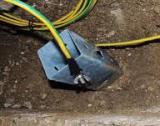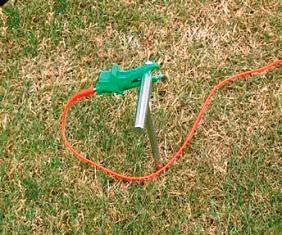Specific electrical resistance of the earth
 The upper layers of the earth's crust, in which the currents of electrical installations can flow, are usually called earth. The property of earth as a current conductor depends on its structure and the components it contains.
The upper layers of the earth's crust, in which the currents of electrical installations can flow, are usually called earth. The property of earth as a current conductor depends on its structure and the components it contains.
The main components of the earth - silica, aluminum oxide, limestone, coal, etc. — are insulators, and the conductivity of the earth depends on the soil solution, that is, on the moisture and salts trapped between the non-conductive solid particles of the components. Thus, the earth has an ionic conductivity, which, unlike the electronic conductivity in metals, has a greater electrical resistance to electric current.
It is common to define the properties of the earth as a current conductor. specific electrical resistance ρ, which means the resistance of a soil cube with edges of 1 cm. This value is determined by the expression:
ρ = RS / l,
Ohm • cm2 / cm, or Ohm / cm, where R is the resistance (Ohm) of a certain volume of soil with a cross section C (cm2) and length l (cm).
The value of the ground resistance ρ depends on the nature of the soil, its moisture content, the content of bases, salts and acids, as well as its temperature.
The range of change in the effective electrical resistance of the earth ρ different soils is huge, for example, clay has a resistance of 1 — 50 Ohm- / m, sandstone 10 — 102 Ohm/ m, and quartz 1012 — 1014 Ohm / m. For comparison, we present the specific electrical resistance of the natural solutions filling the pores and cracks. For example, natural waters, depending on the salts dissolved in them, have a resistance of 0.07 - 600 Ohm / m, of which river and fresh groundwater 60 -300 Ohm / m, and sea and deep waters 0.1 - 1 Ohm / m.
An increase in the content of dissolved substances in the soil, the total moisture content, compaction of its particles, an increase in temperature (if the moisture content does not decrease) lead to a decrease in ρ. Oil and oil impregnation of the soil, as well as freezing, significantly increase ρ.

The earth is heterogeneous, consisting of several layers of soil with different values of ρ. Initially, when calculating grounding and engineering studies, they were based on the assumption of the homogeneity of ρ on the ground in the vertical direction. Now, when calculating grounded electrodes, it is assumed that the earth consists of two layers: the upper one with the resistance ρ1 and the thickness h and the lower one with the resistance ρ2. Such a calculated two-layer model of the earth well reflects the features of changes in the depth of the earth caused by freezing and drying of its surface layer, as well as the influence on the p zone of groundwater.
Analytical calculation of all factors affecting the value of ρ is difficult, therefore, the resistance that meets the accepted calculation accuracy is obtained by direct measurements.
To measure the parameters of the earth's electrical structure — the thickness of the layers and the resistance of each layer — two methods are currently recommended: a vertical test electrode and a vertical electrical measurement. The choice of measurement method depends on the characteristics of the soil and the required measurement accuracy.
See also: How to measure earth resistance
The table below shows the resistance of the most common soils.
Soil resistance Soil type Resistance, Ohm / m Clay 50 Dense limestone 1000-5000 Loose limestone 500-1000 Soft limestone 100-300 Granite and sandstone depending on weathering 1500-10000 Weathered granite and sandstone 100-600 Humus layer 10- 150 Silty soils 20-100 Jurassic marls 30-40 Marl and dense clay 100-200 Mica shale 800 Clay sand 50-500 Silica sand 200-3000 Layered shale soils 50-300 Bare rocky soil 1500-3000 Stony soil covered with grass 300-500 Wetlands From several units to 30 Wet peat soils 5-100
